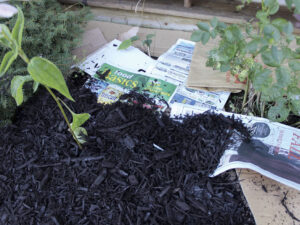Columnists
Weed Barrier 101

Had enough with weeding this year? Now is the perfect time to end the cycle!
Most of the plants we cherish in our gardens started out in the wild until someone decided they would look good around the house. Weeds are simply plants that grow in spots you don’t want them. Most of our landscaping plants (and the weeds) need three things to grow; soil, sunlight and water. If you can take one of these three things away…voila! No more plants. In this case, we are creating a barrier to block the weeds from getting sunlight. Personally, I’m not a fan of landscape fabric because nothing sticks to it and if you live in a windy location, the mulch always seems to blow off exposing the black cloth beneath. I prefer paper or cardboard because it’s sticky when wet.
Here are the products you will need.
• Newspaper or Cardboard (without tape)
• Mulch (any type will do)
• A source of water
Step one: Start by creating a layer of cardboard covering all the soil and weeds. Work around the plants that you would like to save. If you are using newspaper, use at least seven sheets to create your barrier. This fibre barricade will effectively block the weeds below from getting any sun. The cardboard can last up to six months before it naturally breaks down into the soil. (Newspaper lasts less).
 Step two: Completely cover the barrier with your choice of mulch. The mulch is used to hide the cardboard, but also to keep anything from blowing away or shifting. Make sure you put at least 3 inches of mulch down on the garden. As the barrier naturally breaks down into the soil, the mulch replaces it, preventing new seeds/weeds from getting started.
Step two: Completely cover the barrier with your choice of mulch. The mulch is used to hide the cardboard, but also to keep anything from blowing away or shifting. Make sure you put at least 3 inches of mulch down on the garden. As the barrier naturally breaks down into the soil, the mulch replaces it, preventing new seeds/weeds from getting started.
Step three: Thoroughly water your garden. The water helps the mulch stick to the cardboard and the cardboard stick to the soil below.
This system works anywhere that you have soil you want to cover up. You can bury your cardboard with either gravel or mulch. I’ve even tried adding new soil and sod on top to start a new lawn and that worked just fine as well. If after a few years the weeds are starting to creep their way back in, just add another layer of paper on top of the remaining mulch and start the whole process again.
For the record, I can’t personally take credit for this technique. It’s been used for years by more generations than I can count because it really is this simple, and yet highly effective.

Comments (0)